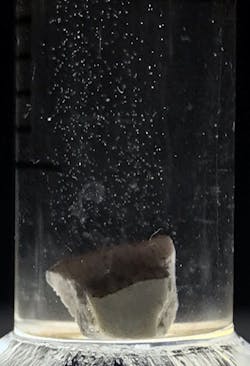Novel chemistries boost downhole mineral scale dissolution performance
By Li Jiang, Suzanne Stewart and Jonathan Abbott, Tendeka
Through systematic, laboratory-based proof of concept tests, Tendeka, a TAQA company, demonstrated that two novel chemistries, applied in combination, accelerated the performance of downhole scale dissolution treatments.
Laboratory tests
Strontium sulfate scale, similar to that found in an offshore environment, was used to conduct the laboratory tests. The first set of tests added selected foaming agents to capture gaseous species such as air entrained in the scale dissolver fluid in the form of micro- and nano-foams. This caused the foams to move toward the surface resulting in sufficient agitation to replace fluid at the scale dissolver interface.
The second technique incorporated a gas generation reaction system into the scale dissolver fluid. Triggered by thermal and/or chemical catalysis, this produced gaseous species, adjacent to the scale-fluid interface, increasing mass transfer in the fluid phase.
Initially, two samples (A and B) were air dried, weighed and placed in measuring cylinders with 50 ml of a commercially available aqueous mixture of chelating agents. A non-ionic surfactant comprising propoxylated-N-tallow alkyltrimethylene diamines was added to cylinder B at a concentration of 200 ppm relative to the total volume of fluid. Both cylinders were kept at 74 F (23 C) under static conditions for five hours. While fluid in cylinder A was completely motionless, micro-bubbles were observed forming and moving from the bottom up in cylinder B.
Production enhancement
At the end of the treatment period, the samples were dried, weighed and the dissolution rates calculated accordingly. The presence of non-ionic micro-foaming agents led to a 2.26-fold increase in the scale dissolution rate in an otherwise identical setting. This was unequivocally attributed to the acceleration of fluid mass transfer at the scale-fluid interface.
Further to the initial investigation, an additional group of non-ionic surfactants with potential foaming capacities also was screened under the same conditions. It was evident that the presence of selected, non-ionic surfactants can significantly enhance the scale dissolution rate by a factor of about two.
In addition, a group of five gas generation reactions were examined to measure their potential to enhance scale dissolution rates. This followed a similar process with the addition of a sophorolipid-based biosurfactant at 100 ppm to remove any hydrocarbons that might have saturated the mineral scale surface. Finally, the gas generator was added at 1 wt%.
The study concluded that an appropriate combination of localized gas generation and foaming at micro- and nanometric dimensions helped enhance the scale dissolution rate when other mechanical agitation means are not possible/practical.
Deferring decline downhole
When treating acid-insoluble sulfate scales, it is widely acknowledged that chelating ligand-based scale dissolvers have excessively slow dissolution rates, insufficient fresh dissolver supply at the scale-fluid interface and limited access by the dissolver fluid to the scale body. As a result, extended well shut-in with static soaking must be adopted leading to deferred production and, in some cases, limited success.
Proof of concept tests performed by Tendeka have shown that micro- and nano-foam formation and localized gas generation can accelerate the rate of fluid mass transfer at the scale-fluid interface and enhance scale dissolution rates.
Utilization of this methodology will create a dynamic environment and, in some cases, will replace the need for mechanical agitation.
About the authors: Li Jiang is production enhancement manager, Suzanne Stewart is vice president for technology and Jonathan Abbott is CTO.
10.31.2022

